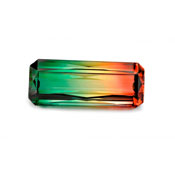Tourmaline
(too r-muh-leen)
HISTORY and LORE
- For centuries, confused with other gems due to similarities in color. Tourmaline was first scientifically identified in the late 1700s.
- Name comes from Sinhalese toramalli, which traditionally referred to mixed gems of various types. (Sinhalese is the official language of Sri Lanka.)
- Became widely regarded as an American gemstone around 1900, when a respected gem specialist praised the tourmaline from deposits in California and Maine. California tourmaline was a favorite with the last empress of China, and she was laid to rest on a pillow carved from it.
- Birthstone for October and gem for the 8th wedding anniversary.
VALUE FACTORS
- Color: Tourmaline has one of the widest ranges of any gem, and occurs in multiple shades of nearly every hue. Pink and green are plentiful and popular. For many years, deep red had highest value. But since the early 1990s, the vivid blues and greens from Paraíba, Brazil have commanded top prices (over $20,000 per carat in finest quality).
- Clarity: Green is typically almost inclusion-free. Most other colors are often lightly included, and minor characteristics are expected. However, red and pink are likely to have visible inclusions; if these aren’t unsightly or threatening, they’re usually considered acceptable.
- Cut: Many faceted shapes and styles. Also cabochons, carvings, fantasy cuts, and beads.
- Carat Weight: Most colors are normally available in sizes up to about 10 or 15 carats.
TREATMENT
Often treated in one or more ways:
- Heat is commonly used to create or improve the color of blue, green, red, pink, and purple tourmaline. Most Paraiba tourmaline is also heat-treated. Results are normally permanent, and there are no special care requirements.
- Irradiation is another common method for creating or improving reds, pinks, and purples. It’s occasional for oranges and yellows too. Irradiated colors sometimes fade if exposed to intense light for a long time. Otherwise, the treatment’s effects are normally permanent, and there are no special care requirements.
- Filling fractures and cavities to improve clarity appearance is common for red and pink tourmaline, and occasional for other colors. Fillings include colorless oils and natural or synthetic resins. Most are normally permanent, and create no special care requirements for gem owners. However, oil eventually deteriorates, and oiled gems should not be exposed to intense light or even mild heats, such as direct sun, or to solvents or other chemicals.
GEMOLOGY
- Conventionally classified as a species, but tourmaline is actually the name for a group of about a dozen related minerals. Most gems come from the species known as elbaite, which has a variable composition that can include aluminum, boron, hydrogen, lithium, oxygen, silicon, and sodium. Color is caused by trace elements such as copper, chromium, iron, manganese, titanium, and vanadium.
- Different types of tourmaline are often designated simply by color, but recognized variety and trade names include the following:
Chrome tourmaline – intense green colored by chromium or vanadium (the same elements that color emeralds).
Indicolite – dark blue, often with a violetish or greenish tinge (colored by iron).
Paraíba tourmaline – vivid blues and greens discovered around 1990 in the Brazilian state for which it’s names (colored mainly by copper).
Rubellite – red or deep pink (usually colored by manganese).
Bicolor tourmaline – shows two different colors side-by-side.
Tricolor tourmaline – shows three different colors side-by-side.
Watermelon tourmaline – has a pink center surrounded by green.
Parti-colored tourmaline – generic term covering bicolor, tricolor, and watermelon.
Cat’s-eye tourmaline – usually blue, green, or pink with a soft cat’s-eye effect caused by hollow tube-like inclusions.
- Tourmaline often displays strong pleochroism – lighter or darker shades of the primary color, depending on the viewing direction. This results from the way the crystal interacts with light. Gems are oriented to show the most attractive shade when cut.
CARE
Tourmaline generally has good to fair wearability. Protected setting is recommended.
- Hardness: Moderate scratch resistance. Rates 7 to 7.5 on the Mohs Hardness Scale.
- Toughness: Good to low resistance to chipping and breaking (largely depending on the type and extent of clarity characteristics).
- Stability: No routine concerns for gem owners.
- Cleaning: Detergent and water (but no hard scrubbing for oiled gems). Liquid cleaner can damage some fracture fillings. Ultrasonic is not safe for gems with noticeable clarity characteristics, or those that are cavity- or fractured-filled.
